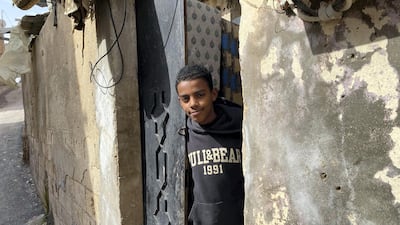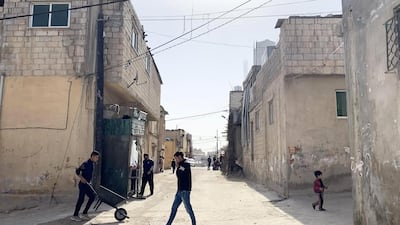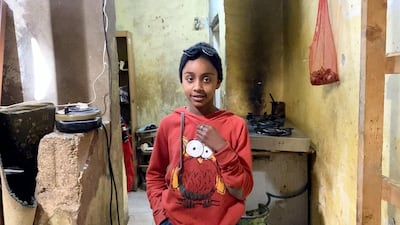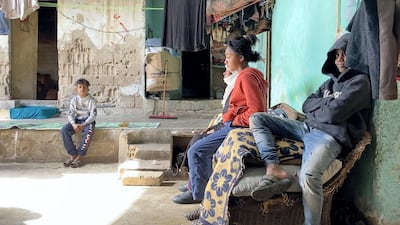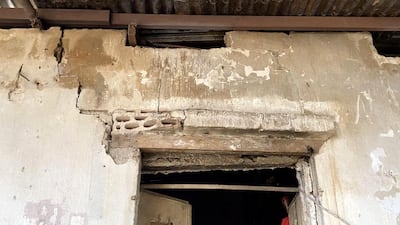When rain falls on the Jerash Valley in northern Jordan, relief spreads among farmers tilling the arid land.
For many of the 50,000 Palestinian inhabitants of the Gaza refugee camp near olive groves in the middle of the valley, the rain brings grief.
Harsh economic conditions this winter have left the camp's residents less able to repair the corrugated metal roofs of their homes, which are notorious for leaking.
"My husband has no work and we cannot afford to eat," Taghreed Yehya, a mother of two in her 20s, said as she showed The National where the rain had leaked into her home despite the plastic sheet fixed under the roof.
The United Nations regards the camp housing refugees from the Gaza Strip as the poorest among the 10 Palestinian camps in Jordan. An economic recession last year, compounded by the coronavirus, has hit its residents hard.
A large proportion of Jordan’s 10 million population are of Palestinian origin. Most of them have Jordanian citizenship and unimpeded right to work, except for refugees from Gaza, who fled to Jordan in the late 1960s, and their descendants.
Taghreed’s husband used to scrape a living as an unskilled labourer on the black market but last year he could not find work even during the olive-picking season, she said.
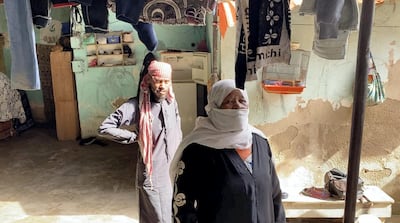
Jordan’s economy was stagnant for a decade before the recession last year. The official unemployment rate has risen to a record 23.9 per cent.
Data about Gaza camp are scarce. The last available figure from the UN show that at least half the camp’s inhabitants were living below Jordan’s official poverty line of $1,140 per capita per year in 2013, and aid workers say socio-economic conditions have not improved since.
“Do-gooders are many,” Taghreed said when asked how the family was able to eat and pay the $50 monthly rent.
They used to fix their roof before every winter, but this year they cannot afford to do repairs and replace the worn-out metal sheets, which cost $6 a square metre.
An architect who visited the camp said the roofs leak because the slope of the corrugated metal sheets is often wrong, and because of poor joining. Other roofs made of concrete are too thin.
But the camp “has a pedestrian feel” absent in the rest of Jordan because people can walk about without worrying about vehicles, he said.
The camp began as a collection of tents placed in a chessboard pattern that housed 12,500 people from Gaza in the 1960s. These were replaced with homes made of concrete blocks. Neighbourhoods in the camp are named after the first families that lived in them.
Sewage flows on the narrow streets where children gather. The camp's UN-run schools partially re-opened last week after being closed last year because of the pandemic.
Many of the children could not take part in online classes because their parents cannot afford internet connections.
Gazan refugees are barred from government health insurance and social programmes. Unlike most residents of Jordan, including Syrian and Iraqi refugees, they are excluded from enrolling in the public education system.
Roughly one-third of the estimated 150,000 Gazan refugees in Jordan live at the camp in Jerash, 47 kilometres north of Amman. The authorities changed its name to Jerash camp, but it is still known as Gaza camp.
Unlike other Palestinian refugees, who fled after the creation of Israel in 1948 and from the Jordan-administered West Bank in 1967, Palestinians from Gaza came to Jordan after Israel overran the strip in 1967, when it was under Egyptian administration.
Jordanian authorities saw granting full access to the Gaza refugees as a political step with little return.
But last week the Palestine Committee in the legislature told Interior Minister Samir Mubeideen at a meeting that the government should take measures to help “the sons of Gaza” without granting them citizenship.
Although Jordan’s parliament has mostly nominal powers the meeting highlighted their plight locally.
The committee urged the minister to grant residents from Gaza access to the public education and health systems, lower travel and other fees on them, and ease issuance of temporary passports and residencies, as well as further easing of restrictions on property leasing and purchase.
Inside another leaking home at Gaza camp, Wafa Al Bureisi had moved her gas stove to the corridor, the only part of her small house that was dry. The young mother has four children and her husband is unemployed.
Her next door neighbour, Nousra Al Obeid, 60, moved here from another Palestinian camp when she got married in the 1970s.
She said life in the Gaza camp had been mostly about suffering, and “water seeping from above and from below”.
Her husband died two decades ago and her household includes a son diagnosed with mental illness and two daughters who were divorced last year.
Mariam, a member of the charity Amani Al Atfal, set up by Jordanian women to help Gaza camp residents, said one of the effects of the sinking economy had been unemployed men divorcing their wives and leaving the mothers to fend for the children.
“People in Gaza camp are like visible ghosts,” she said. “All they care about is how to find food for today."
